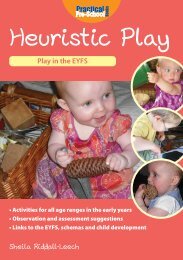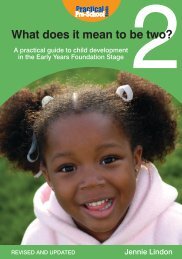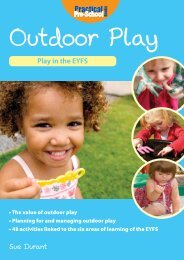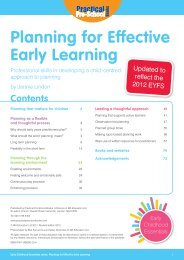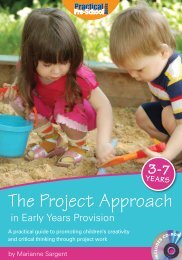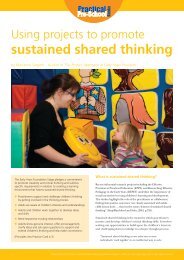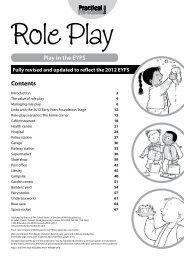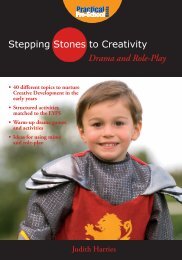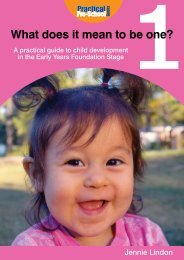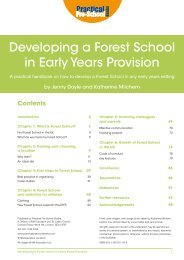Play in the EYFS Contents - Practical Pre-School Books
Play in the EYFS Contents - Practical Pre-School Books
Play in the EYFS Contents - Practical Pre-School Books
Create successful ePaper yourself
Turn your PDF publications into a flip-book with our unique Google optimized e-Paper software.
Sensory play <strong>in</strong> action<br />
or whe<strong>the</strong>r <strong>in</strong> fact this is good for develop<strong>in</strong>g a healthy<br />
immune system. Obviously, eat<strong>in</strong>g soil and mud should not<br />
be actively encouraged. If appropriate, consider recreat<strong>in</strong>g<br />
meals of ‘worms’ (wholemeal spaghetti) and ‘mud pies’<br />
(mashed potato and gravy), muddy stones (cocoa powder<br />
mixed with cereal) or creat<strong>in</strong>g ‘gravel or stones’ (from<br />
flapjack held toge<strong>the</strong>r with sultana or date ‘mud’).<br />
Who is this suitable for?<br />
Always carry out a risk assessment on <strong>the</strong> area first to<br />
ensure children’s health and safety. Talk to children about<br />
<strong>the</strong> importance of <strong>the</strong>m wash<strong>in</strong>g <strong>the</strong>ir hands with soap<br />
after play and not touch<strong>in</strong>g <strong>the</strong>ir eyes or mouth. Soil<br />
can conta<strong>in</strong> harmful bacteria so, if offer<strong>in</strong>g to babies, do<br />
so on a one-to-one basis. If offer<strong>in</strong>g to young children<br />
do so <strong>in</strong> small groups. Babies can be supported <strong>in</strong> <strong>the</strong>ir<br />
<strong>in</strong>vestigations by hold<strong>in</strong>g <strong>the</strong>m as <strong>the</strong>y ‘stand’ on soil, or<br />
by spr<strong>in</strong>kl<strong>in</strong>g it on <strong>the</strong>ir f<strong>in</strong>gers or toes. Whatever age you<br />
choose to offer it to, it is important that you yourself are<br />
comfortable so that children do not pick up any concerns.<br />
If appropriate, babies and young children can play with<br />
gloop, tapioca or clean sand <strong>in</strong>stead.<br />
pour<strong>in</strong>g and fill<strong>in</strong>g; wonderfully responsive to stamp<strong>in</strong>g<br />
and splosh<strong>in</strong>g, and creat<strong>in</strong>g ‘slurp<strong>in</strong>g’ sound effects. Allow<br />
<strong>the</strong> watery sand to settle and <strong>the</strong> sand and water separate<br />
or <strong>the</strong> water dries up, revers<strong>in</strong>g <strong>the</strong> whole process. Given<br />
this wealth of possibilities, it is easy to see children’s special<br />
fasc<strong>in</strong>ation for sand.<br />
Whe<strong>the</strong>r offered a beach, a deep purpose-built sand tray,<br />
or a makeshift conta<strong>in</strong>er of sand, children will f<strong>in</strong>d much<br />
to occupy and excite <strong>the</strong>m. With <strong>the</strong> simple addition of<br />
water, some conta<strong>in</strong>ers for digg<strong>in</strong>g and transport<strong>in</strong>g,<br />
or some smooth pebbles or unusual shells, play can be<br />
fur<strong>the</strong>r extended and transformed. In <strong>the</strong> hands of a<br />
resourceful <strong>in</strong>dividual, sand on its own has <strong>the</strong> potential<br />
to be a lunar landscape, a desert scene, a blank canvass,<br />
a truly <strong>in</strong>teractive ‘whiteboard’, an exotic meal, a witches<br />
Sand <strong>Play</strong><br />
What is it?<br />
Few children could resist an opportunity to play with<br />
sand. Like water play, <strong>the</strong> flexibility of sand gives it almost<br />
magical qualities. Matterson comments on <strong>the</strong> special<br />
qualities of sand which need to be experienced first to be<br />
understood (1975). Dry sand is great for pour<strong>in</strong>g and fill<strong>in</strong>g.<br />
It can feel cold or warm to touch, squeaks when squashed<br />
and moves <strong>in</strong> an <strong>in</strong>trigu<strong>in</strong>g way, behav<strong>in</strong>g more like a liquid<br />
than a solid. When water is added to sand its properties<br />
and texture are, bit by bit, transformed open<strong>in</strong>g up <strong>the</strong><br />
potential for mark-mak<strong>in</strong>g, pattern-mak<strong>in</strong>g, impr<strong>in</strong>ts,<br />
shapes, construction and manipulation. Add ‘too much’<br />
water and it changes aga<strong>in</strong> to a sloppy liquid, great for<br />
Sensory <strong>Play</strong> 27




